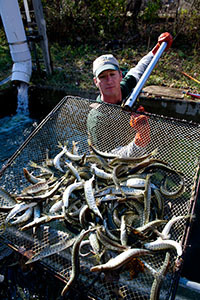|
Nov. 28, 2016
Contact: Matt Hughes, 269-668-2696 ext. 24 or Elyse Walter, 517-284-6071
State rears and stocks muskellunge to create fishing opportunities throughout Michigan
 The Michigan Department of Natural Resources recently stocked 25,740 muskellunge fingerlings into 12 waterbodies located throughout the state in an effort to further enhance Michigan’s world-class fisheries. The Michigan Department of Natural Resources recently stocked 25,740 muskellunge fingerlings into 12 waterbodies located throughout the state in an effort to further enhance Michigan’s world-class fisheries.
Michigan is home to two strains of naturally reproducing muskellunge, Great Lakes and northern. The DNR has been rearing muskellunge in its hatcheries since the 1950s. While the hatchery program initially focused on the northern muskellunge strain, it has shifted focus in recent years to the Great Lakes strain, as it is native to Michigan and widely distributed in waterbodies throughout the Lower Peninsula and eastern region of the Upper Peninsula.
Since 2011, the DNR has collected eggs and milt (sperm) from adult muskellunge in the Lake St. Clair/Detroit River system. The offspring then are reared at Wolf Lake State Fish Hatchery in Mattawan. This hatchery is the only facility in the state currently capable of rearing this species. The muskellunge are reared in hatchery tanks and then transferred to outside ponds after a few months.
Historically, muskellunge were reared by stocking fry in ponds and allowing them to grow by eating natural food, similar to how the DNR currently rears walleye. Because of the highly cannibalistic nature of muskellunge, the success of these rearing efforts was highly variable and often produced low numbers. Current rearing efforts at Wolf Lake State Fish Hatchery produce a much higher survival rate and more stable, predictable production.
“We are continuing to make great headway in our efforts to increase muskellunge fishing opportunities for anglers,” said DNR fisheries biologist Matt Hughes, who oversees the rearing program at Wolf Lake State Fish Hatchery. “With time and experience we’ve stabilized and increased production so more and more waterbodies can be stocked.”
Due to infrastructure improvements at Wolf Lake State Fish Hatchery, staff has been able to increase the size of fingerlings stocked each year since the program began. Increased stocking size leads to better survival.
Below is a chart of the waterbodies stocked this fall with 8- to 10-inch-long muskellunge.
| Waterbody |
County |
Number Stocked |
| Belleville Lake |
Wayne |
1,905 |
| Cooke Dam Pond |
Iosco |
2,913 |
| Lake Michigan-Little Bay de Noc |
Delta |
5,000 |
| Lake Margarethe |
Crawford |
2,880 |
| Lake Ovid |
Clinton |
410 |
| Lake Winyah |
Alpena |
2,295 |
| Murray Lake |
Kent |
640 |
| North Manistique Lake |
Luce |
1,700 |
| Ross Lake |
Gladwin |
441 |
| Teal Lake |
Marquette |
699 |
| White Lake |
Muskegon |
3,857 |
| Wixom Lake |
Gladwin |
3,000 |
| Total: 25,740 |
Wolf Lake State Fish Hatchery will be over-wintering a small number of fingerlings that will be stocked in the spring into future broodstock lakes. It is estimated these fish will be 14 inches at the time of stocking.
An additional 1,110 northern strain muskellunge were stocked in Chicagon Lake (Iron County). These fish came from the Wisconsin Department of Natural resources as part of a cooperative agreement to trade Great Lakes strain muskellunge for northern strain muskellunge.
For even more information on the DNR’s fish-stocking efforts, check out the Fish Stocking Database at www.michigandnr.com/fishstock/.
/Editor's note: Accompanying photo is available below for download. Suggested caption follows.
The DNR recently completed this year's muskellunge stocking efforts, putting fingerling-size fish (like those shown here) into 12 waterbodies located throughout Michigan./
The Michigan Department of Natural Resources is committed to the conservation, protection, management, use and enjoyment of the state’s natural and cultural resources for current and future generations. For more information, go to www.michigan.gov/dnr.
|

 The Michigan Department of Natural Resources recently stocked 25,740 muskellunge fingerlings into 12 waterbodies located throughout the state in an effort to further enhance Michigan’s world-class fisheries.
The Michigan Department of Natural Resources recently stocked 25,740 muskellunge fingerlings into 12 waterbodies located throughout the state in an effort to further enhance Michigan’s world-class fisheries.




